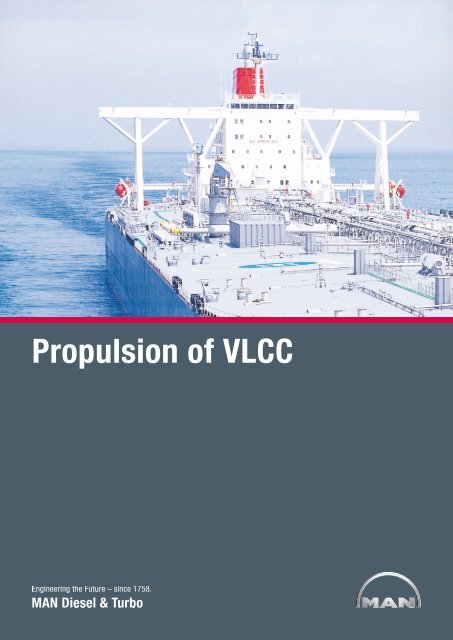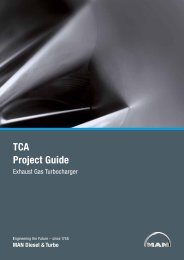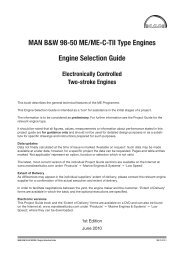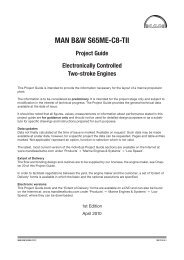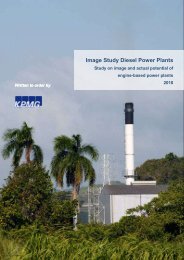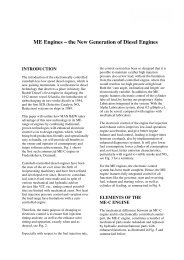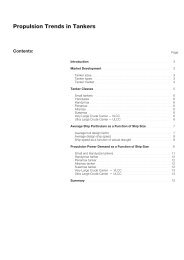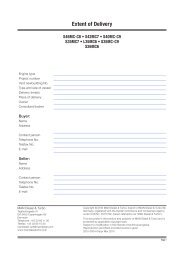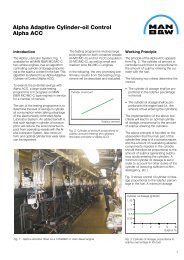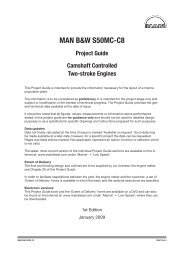Propulsion of VLCC - MAN Diesel & Turbo
Propulsion of VLCC - MAN Diesel & Turbo
Propulsion of VLCC - MAN Diesel & Turbo
Create successful ePaper yourself
Turn your PDF publications into a flip-book with our unique Google optimized e-Paper software.
<strong>Propulsion</strong> <strong>of</strong> <strong>VLCC</strong>
Contents<br />
Introduction..................................................................................................5<br />
EEDI.and.Major.Ship.and.Main.Engine.Parameters........................................6<br />
Energy.Efficiency.Design.Index.(EEDI)......................................................6<br />
Major.propeller.and.engine.parameters....................................................7<br />
320,000.dwt.<strong>VLCC</strong>..................................................................................8<br />
Main.Engine.Operating.Costs.–.16.3.knots....................................................9<br />
Fuel.consumption.and.EEDI.....................................................................9<br />
Operating.costs..................................................................................... 12<br />
Main.Engine.Operating.Costs.–.15.5.knots.................................................. 13<br />
Fuel.consumption.and.EEDI................................................................... 13<br />
Operating.costs..................................................................................... 16<br />
Summary.................................................................................................... 17
<strong>Propulsion</strong> <strong>of</strong> <strong>VLCC</strong><br />
Introduction<br />
The.size.<strong>of</strong>.Very.Large.Crude.Carriers,.<br />
<strong>VLCC</strong>s,. see. Fig.. 1,. is. normally. within.<br />
the. deadweight. range. <strong>of</strong>. 250,000-<br />
320,000. dwt. and. the. ship’s. overall.<br />
length.is.about.330-335.m.<br />
Recent.development.steps.have.made.<br />
it.possible.to.<strong>of</strong>fer.solutions.which.will.<br />
enable. significantly. lower. transporta-<br />
tion.costs.for.<strong>VLCC</strong>s.as.outlined.in.the.<br />
following.<br />
One.<strong>of</strong>.the.goals.in.the.marine.industry.<br />
today. is. to. reduce. the. impact. <strong>of</strong>. CO2.<br />
emissions. from. ships. and,. therefore,.<br />
to.reduce.the.fuel.consumption.for.the.<br />
Fig. 1: A <strong>VLCC</strong><br />
propulsion.<strong>of</strong>.ships.to.the.widest.pos-<br />
sible.extent.at.any.load.<br />
This. also. means. that. the. inherent. de-<br />
sign.CO2.index.<strong>of</strong>.a.new.ship,.the.so-<br />
called. Energy. Efficiency. Design. Index.<br />
(EEDI),. will. be. reduced.. Based. on. an.<br />
average. reference. CO2. emission. from.<br />
existing.tankers,.the.CO2.emission.from.<br />
new.tankers.in.gram.per.dwt.per.nauti-<br />
cal.mile.must.be.equal.to.or.lower.than.<br />
the.reference.emission.figures.valid.for.<br />
the.specific.tanker.<br />
This. drive. may. <strong>of</strong>ten. result. in. opera-<br />
tion. at. lower. than. normal. service. ship.<br />
speeds. compared. to. earlier,. resulting.<br />
in. reduced. propulsion. power. utilisa-<br />
tion..The.design.ship.speed.at.Normal.<br />
Continuous. Rating. (NCR),. including.<br />
15%.sea.margin,.used.to.be.as.high.as.<br />
16.0-16.5.knots..Today,.the.ship.speed.<br />
may.be.expected.to.be.lower,.possibly.<br />
15.5.knots,.or.even.lower..However,.so.<br />
far.only.few,.if.any,.have.specified.lower.<br />
installed.power.for.new.<strong>VLCC</strong>s.<br />
A.more.technically.advanced.develop-<br />
ment. drive. is. to. optimise. the. aftbody.<br />
and. hull. lines. <strong>of</strong>. the. ship. –. including.<br />
bulbous. bow,. also. considering. opera-<br />
tion.in.ballast.condition.–.making.it.pos-<br />
sible. to. install. propellers. with. a. larger.<br />
propeller. diameter. and,. thereby,. ob-<br />
<strong>Propulsion</strong>.<strong>of</strong>.<strong>VLCC</strong><br />
5
taining. higher. propeller. efficiency,. but.<br />
at.a.reduced.optimum.propeller.speed.<br />
As.the.two-stroke.main.engine.is.direct-<br />
ly.coupled.with.the.propeller,.the.intro-<br />
duction.<strong>of</strong>.the.‘Green’.ultra.long.stroke.<br />
G80ME-C.engine.with.even.lower.than.<br />
usual. shaft. speed. will. meet. this. drive.<br />
and. target. goal.. The. main. dimensions.<br />
for.this.engine.type,.and.for.other.exist-<br />
ing.<strong>VLCC</strong>.engines,.are.shown.in.Fig..2.<br />
Based. on. a. case. study. <strong>of</strong>. a. 320,000.<br />
dwt. <strong>VLCC</strong>,. this. paper. shows. the. in-<br />
fluence. on. fuel. consumption. when.<br />
choosing. the. new. G80ME-C. engine.<br />
compared.with.existing.<strong>VLCC</strong>.engines..<br />
The. layout. ranges. <strong>of</strong>. 6. and. 7G80ME-<br />
C9.2. engines. compared. with. existing.<br />
engines.are.shown.in.Fig..3.<br />
13,586<br />
2,656<br />
1,736<br />
5,020<br />
S80ME-C8.2<br />
14,071<br />
2,840<br />
1,890<br />
EEDI and Major Ship and Main Engine<br />
Parameters<br />
Energy Efficiency Design Index (EEDI)<br />
The. Energy. Efficiency. Design. Index.<br />
(EEDI).is.conceived.as.a.future.mandatory.<br />
instrument. to. be. calculated. and.<br />
made. as. available. information. for. new.<br />
ships.. EEDI. represents. the. amount. <strong>of</strong>.<br />
CO2.in.gram.emitted.when.transporting.<br />
one.deadweight.tonnage.<strong>of</strong>.cargo.one.<br />
nautical.mile.<br />
For. tankers,. the. EEDI. value. is. essentially.<br />
calculated. on. the. basis. <strong>of</strong>. maximum.cargo.capacity,.propulsion.power,.ship.speed,.SFOC.and.fuel.type..However,.certain.correction.factors.are.applicable,.<br />
e.g.. for. installed. Waste. Heat.<br />
Recovery. systems.. To. evaluate. the.<br />
achieved. EEDI,. a. reference. value. for.<br />
5,374<br />
S80ME-C9.2<br />
Fig. 2: Main dimensions for a G80ME-C9.2 engine and for other existing <strong>VLCC</strong> engines<br />
6 <strong>Propulsion</strong>.<strong>of</strong>.<strong>VLCC</strong><br />
14,879<br />
3,010<br />
1,960<br />
G80ME-C9.2<br />
the.specific.ship.type.and.the.specified.<br />
cargo.capacity.is.used.for.comparison.<br />
The.main.engine’s.75%.SMCR.(Speci-<br />
fied. Maximum. Continuous. Rating). fig-<br />
ure.is.as.standard.applied.in.the.calcu-<br />
lation.<strong>of</strong>.the.EEDI.figure,.in.which.also.<br />
the.CO2.emission.from.the.auxiliary.en-<br />
gines.<strong>of</strong>.the.ship.is.included.<br />
According. to. the. rules. finally. decided.<br />
on.15.July.2011,.the.EEDI.<strong>of</strong>.a.new.ship.<br />
is.reduced.to.a.certain.factor.compared.<br />
to.a.reference.value..Thus,.a.ship.built.<br />
after. 2025. is. required. to. have. a. 30%.<br />
lower.EEDI.than.the.reference.figure.<br />
13,889<br />
5,680 5,000<br />
2,835<br />
1,800<br />
S90ME-C8.2
<strong>Propulsion</strong><br />
SMCR power<br />
kW<br />
35,000 4-bladed FP-propellers<br />
constant ship speed coefficient ∝ = 0.28<br />
30,000<br />
25,000<br />
20,000<br />
15,000<br />
10,000<br />
SMCR power and speed are inclusive <strong>of</strong>:<br />
� 15% sea margin<br />
� 10% engine margin<br />
� 5% light running<br />
T des = 21.0 m<br />
G80ME-C9.2<br />
Bore = 800 mm<br />
Stroke = 3,720 mm<br />
Vpist = 8.43 m/s (8.93 m/s)<br />
S/B = 4.65<br />
MEP = 21 bar<br />
L1 = 4,450 kW/cyl. at 68 r/min<br />
= 4,710 kW/cyl. at 72 r/min)<br />
(L 1<br />
320,000 dwt <strong>VLCC</strong><br />
Increased propeller diameter<br />
G80ME-C9.2<br />
M4’<br />
7G80ME-C9.2<br />
6G80ME-C9.2<br />
M4<br />
Possible<br />
Dprop = 11.0 m<br />
(=52.4% T des )<br />
M3<br />
M3’<br />
∝<br />
∝<br />
∝<br />
∝<br />
Possible<br />
Dprop = 10.5 m<br />
(=50.0% T des )<br />
7S80ME-C9.2<br />
6S90ME-C8.2<br />
6S90ME-C7.1<br />
72 r/min<br />
∝<br />
∝<br />
M2’<br />
6S80ME-C9.2<br />
M’ = SMCR (15.5 kn)<br />
M1’ = 27,060 kW x 78.0 r/min 6S80ME-C9.2<br />
M2’ = 26,860 kW x 76.0 r/min 6S90ME-C7.1<br />
M3’ = 26,040 kW x 68.0 r/min 6G80ME-C9.2<br />
M4’ = 25,370 kW x 62.0 r/min 7G80ME-C9.2<br />
M1, M2<br />
M1’<br />
78r/min<br />
76r/min<br />
Existing<br />
Dprop = 10.0 m<br />
(=47.6% T des )<br />
14.0 kn<br />
15.0 kn<br />
15.5 kn<br />
Existing<br />
Dprop = 9.5 m<br />
(=45.2% T des )<br />
16.0 kn<br />
16.5 kn<br />
16.3 kn<br />
M = SMCR (16.3 kn)<br />
M1 = 31,570 kW x 78.0 r/min 7S80ME-C9.2<br />
M2 = 31,570 kW x 78.0 r/min 6S90ME-C8.2<br />
M3 = 30,380 kW x 68.0 r/min 7G80ME-C9.2<br />
M4 = 30,090 kW x 65.7 r/min 7G80ME-C9.2<br />
40 50 60 70 80 90 r/min<br />
Engine/propeller speed at SMCR<br />
Fig. 3: Different main engine and propeller layouts and SMCR possibilities (M1, M2, M3, M4 for 16.3 knots and M1’, M2’, M3’, M4’ for 15.5 knots) for a<br />
320,000 dwt <strong>VLCC</strong> operating at 16.3 knots and 15.5 knots, respectively.<br />
Major propeller and engine parameters<br />
In.general,.the.larger.the.propeller.diameter,.the.higher.the.propeller.efficiency.and.<br />
the. lower. the. optimum. propeller. speed.<br />
referring.to.an.optimum.ratio.<strong>of</strong>.the.propeller.pitch.and.propeller.diameter.<br />
When.increasing.the.propeller.pitch.for.<br />
a.given.propeller.diameter.with.optimum.<br />
pitch/diameter. ratio,. the. correspond-<br />
ing. propeller. speed. may. be. reduced.<br />
and. the. efficiency. will. also. be. slightly.<br />
reduced,. <strong>of</strong>. course. depending. on. the.<br />
degree.<strong>of</strong>.the.changed.pitch..The.same.<br />
is.valid.for.a.reduced.pitch,.but.here.the.<br />
propeller.speed.may.increase.<br />
The.efficiency.<strong>of</strong>.a.two-stroke.main.en-<br />
gine.particularly.depends.on.the.ratio.<strong>of</strong>.<br />
the. maximum. (firing). pressure. and. the.<br />
mean.effective.pressure..The.higher.the.<br />
ratio,. the. higher. the. engine. efficiency,.<br />
i.e..the.lower.the.Specific.Fuel.Oil.Con-<br />
sumption.(SFOC).<br />
Furthermore,.the.higher.the.stroke/bore.<br />
ratio.<strong>of</strong>.a.two-stroke.engine,.the.high-<br />
er. the. engine. efficiency.. This. means,.<br />
for. example,. that. an. ultra. long. stroke.<br />
engine. type,. as. the. G80ME-C9,. may.<br />
have.a.higher.efficiency.compared.with.<br />
a. shorter. stroke. engine. type,. like. a.<br />
K80ME-C9.<br />
Furthermore,. the. application. <strong>of</strong>. new.<br />
propeller. design. technologies,. NPT.<br />
propellers,. motivates. use. <strong>of</strong>. main. en-<br />
gines. with. lower. rpm.. Thus,. for. the.<br />
same.propeller.diameter,.these.propel-<br />
ler.types.are.claimed.to.have.an.about.<br />
6%. improved. overall. efficiency. gain. at.<br />
about.10%.lower.propeller.speed.<br />
Hence,.the.advantage.<strong>of</strong>.the.new.lower.<br />
speed. engines. can. be. utilised. also. in.<br />
case.a.correspondingly.larger.propeller.<br />
cannot.be.accumulated.<br />
<strong>Propulsion</strong>.<strong>of</strong>.<strong>VLCC</strong><br />
7
320,000 dwt <strong>VLCC</strong><br />
For. a. 320,000. dwt. <strong>VLCC</strong>. tanker,. the.<br />
following.case.study.illustrates.the.potential.for.reducing.fuel.consumption.by.<br />
increasing. the. propeller. diameter. and.<br />
introducing. the. G80ME-C9.2. as. main.<br />
engine.. The. ship. particulars. assumed.<br />
are.as.follows:<br />
Scantling.draught. m. 22.5<br />
Design.draught. m. 21.0<br />
Length.overall. m. 333.0<br />
Length.between.pp. m. 319.0<br />
Breadth. m. 60.0<br />
Sea.margin. %. 15<br />
Engine.margin. %. 10<br />
Design.ship.speed. kn. 16.3.and.15.5<br />
Type.<strong>of</strong>.propeller. . FPP<br />
No..<strong>of</strong>.propeller.blades. . 4<br />
Propeller.diameter. m. target<br />
Based. on. the. above-stated. average.<br />
ship. particulars. assumed,. we. have.<br />
made. a. power. prediction. calculation.<br />
(Holtrop. &. Mennen’s. Method). for. different.design.ship.speeds.and.propeller.<br />
diameters,. and. the. corresponding.<br />
SMCR. power. and. speed,. point. M,. for.<br />
propulsion. <strong>of</strong>. the. <strong>VLCC</strong>. is. found,. see.<br />
Fig.. 3.. The. propeller. diameter. change.<br />
corresponds.approximately.to.the.constant.ship.speed.factor.α.=.0.28.[PM2.=.<br />
PM1.x.(n2/n1) α ].<br />
Referring. to. the. two. ship. speeds. <strong>of</strong>.<br />
16.3.knots.and.15.5.knots,.respectively,.four.potential.main.engine.types.and.<br />
pertaining. layout. diagrams. and. SMCR.<br />
points.have.been.drawn-in.in.Fig..3,.and.<br />
the. main. engine. operating. costs. have.<br />
been. calculated. and. described. below.<br />
individually. for. each. ship. speed. case..<br />
The.layout.diagram.<strong>of</strong>.the.G80ME-C9.2.<br />
below.or.equal.to.68.r/min.is.especially.<br />
suitable.for.<strong>VLCC</strong>s.whereas.the.speed.<br />
8 <strong>Propulsion</strong>.<strong>of</strong>.<strong>VLCC</strong><br />
range.from.68.to.72.r/min.is.particularly.<br />
suitable.for.e.g..container.vessels.<br />
It.should.be.noted.that.the.ship.speed.<br />
stated.refers.to.NCR.=.90%.SMCR.including.<br />
15%. sea. margin.. If. based. on.<br />
calm. weather,. i.e.. without. sea. margin,.<br />
the. obtainable. ship. speed. at. NCR. =.<br />
90%. SMCR. will. be. about. 0.7. knots.<br />
higher.<br />
If.based.on.75%.SMCR,.as.applied.for.<br />
calculation.<strong>of</strong>.the.EEDI,.the.ship.speed.<br />
will.be.about.0.1.knot.lower,.still.based.<br />
on. calm. weather. conditions,. i.e.. with-<br />
out.any.sea.margin.
Main Engine Operating Costs –<br />
16.3 knots<br />
The. calculated. main. engine. examples.<br />
are.as.follows:<br />
16.3.knots<br />
1.. 7S80ME-C9.2..<br />
. M1.=.31,570.kW.x.78.0.r/min<br />
2.. 6S90ME-C8.2.<br />
. M2.=.31,570.kW.x.78.0.r/min.<br />
3.. 7G80ME-C9.2.<br />
. M3.=.30,380.kW.x.68.0.r/min.<br />
4.. 7G80ME-C9.2.<br />
. M4.=.30,090.kW.x.65.7.r/min.<br />
The.main.engine.fuel.consumption.and.<br />
operating. costs. at. N. =. NCR. =. 90%.<br />
SMCR. have. been. calculated. for. the.<br />
above.four.main.engine/propeller.cases.<br />
operating. on. the. relatively. high. ship.<br />
speed. <strong>of</strong>. 16.3. knots,. as. <strong>of</strong>ten. used.<br />
earlier..Furthermore,.the.corresponding.<br />
EEDI.has.been.calculated.on.the.basis.<br />
<strong>of</strong>.the.75%.SMCR-related.figures.(with-<br />
out.sea.margin).<br />
Fuel consumption and EEDI<br />
Fig.. 4. shows. the. influence. <strong>of</strong>. the. propeller.diameter.when.going.from.about.<br />
10.0. to. 11.0. m.. Thus,. N4. for. the.<br />
7G80ME-C9.2.with.an.11.0.m.propeller.<br />
diameter. has. a. propulsion. power.<br />
demand. that. is. about. 4.7%. lower.<br />
compared. with. N1. and. N2. valid. for.<br />
the. 7S80ME-C9.2. and. 6S90ME-C8.2,.<br />
both.with.a.propeller.diameter.<strong>of</strong>.about.<br />
10.0.m.<br />
<strong>Propulsion</strong> <strong>of</strong> 320,000 dwt <strong>VLCC</strong> – 16.3 knots<br />
Expected propulsion power demand at N = NCR = 90% SMCR<br />
<strong>Propulsion</strong> power<br />
Relative power<br />
demand at N = NCR<br />
reduction<br />
kW<br />
30,000<br />
Inclusive <strong>of</strong> sea margin = 15%<br />
28,410 kW 28,410 kW<br />
%<br />
12<br />
27,340 kW 27,080 kW 11<br />
25,000<br />
20,000<br />
15,000<br />
10,000<br />
5,000<br />
0<br />
Dprop:<br />
0%<br />
7S80ME-C9.2<br />
N1<br />
10.0 m<br />
0%<br />
6S90ME-C8.2<br />
N2<br />
10.0 m<br />
3.8%<br />
7G80ME-C9.2<br />
N3<br />
10.8 m<br />
Fig. 4: Expected propulsion power demand at NCR for 16.3 knots<br />
4.7%<br />
7G80ME-C9.2<br />
N4<br />
11.0 m<br />
10<br />
9<br />
8<br />
7<br />
6<br />
5<br />
4<br />
3<br />
2<br />
1<br />
0<br />
<strong>Propulsion</strong>.<strong>of</strong>.<strong>VLCC</strong><br />
9
<strong>Propulsion</strong> <strong>of</strong> 320,000 dwt <strong>VLCC</strong> – 16.3 knots<br />
Expected SFOC<br />
SFOC<br />
g/kWh<br />
174<br />
173<br />
172<br />
171<br />
170<br />
169<br />
168<br />
167<br />
166<br />
165<br />
164<br />
163<br />
162<br />
161<br />
160<br />
25 30 35 40 45 50 55 60 65 70 75 80 85 90 95 100 % SMCR<br />
Engine shaft power<br />
N = NCR M = SMCR<br />
Fig. 5: Expected SFOC for 16.3 knots<br />
10 <strong>Propulsion</strong>.<strong>of</strong>.<strong>VLCC</strong><br />
IMO Tier ll<br />
ISO ambient conditions<br />
LCV = 42,700 kJ/kg<br />
Standard high-load<br />
optimised engines<br />
N1<br />
N2<br />
N4<br />
N3<br />
M1 7S80ME-C9.2<br />
M2 6S90ME-C8.2<br />
M4 7G80ME-C9.2 11.0 m<br />
M3 7G80ME-C9.2 10.8 m<br />
Savings<br />
in SFOC<br />
0%<br />
0.6%<br />
1.0%<br />
Dprop<br />
10.0 m<br />
10.0 m<br />
Fig..5.shows.the.influence.on.the.main.<br />
engine.efficiency,.indicated.by.the.Spe-<br />
cific. Fuel. Oil. Consumption,. SFOC,. for.<br />
the. four. cases.. N3. =. 90%. M3. for. the.<br />
7G80ME-C9.2. has. an. SFOC. <strong>of</strong>. 164.1.<br />
g/kWh,. whereas. the. N4. =. 90%. M4,.<br />
also.for.the.7G80ME-C9.2,.has.a.high-<br />
er. SFOC. <strong>of</strong>. 164.8. g/kWh. because. <strong>of</strong>.<br />
the.higher.mean.effective.pressure.<br />
The. 164.8. g/kWh. SFOC. <strong>of</strong>. the. N4. for.<br />
the.7G80ME-C9.2.is.0.6%.lower.com-<br />
pared. with. N1. for. the. nominally. rated.<br />
7S80ME-C9.2.with.an.SFOC.<strong>of</strong>.165.8.<br />
g/kWh.. This. is. because. <strong>of</strong>. the. higher.<br />
stroke/bore.ratio.<strong>of</strong>.this.G-engine.type.
When.multiplying.the.propulsion.power.<br />
demand. at. N. (Fig.. 4). with. the. SFOC.<br />
(Fig.. 5),. the. daily. fuel. consumption. is.<br />
found. and. is. shown. in. Fig.. 6.. Compared.<br />
with. N1. for. the. 7S80ME-C9.2,.<br />
the.total.reduction.<strong>of</strong>.fuel.consumption.<br />
<strong>of</strong>.the.7G80ME-C9.2.at.N4.is.about.5.3.%.<br />
(see. also. the. above-mentioned. 4.7%.<br />
and.0.6%).<br />
The. reference. and. the. actual. EEDI.<br />
figures. have. been. calculated. and. are.<br />
shown. in. Fig.. 7. (EEDIRef. =. 1,218.8. x.<br />
DWT. -0.488 ,. 15. July. 2011).. As. can. be.<br />
seen.for.all.four.cases,.the.actual.EEDI.<br />
figures.are.higher.than.or.equal.to.the.<br />
reference.figure..However,.this.is.to.be.<br />
expected.for.<strong>VLCC</strong>.operation.on.a.ship.<br />
speed.as.high.as.16.3.knots.<br />
<strong>Propulsion</strong> <strong>of</strong> 320,000 dwt <strong>VLCC</strong> – 16.3 knots<br />
Expected fuel consumption at N = NCR = 90% SMCR<br />
Fuel consumption<br />
IMO Tier ll<br />
<strong>of</strong> main engine<br />
ISO ambient conditions<br />
t/24h<br />
LCV = 42,700 kJ/kg<br />
<strong>Propulsion</strong> <strong>of</strong> 320,000 DWT <strong>VLCC</strong> – 16.3 knots<br />
Energy Efficiency Design Index (EEDI) 75% SMCR; 16.2 kn without sea margin<br />
Reference and actual EEDI<br />
CO 2 emissions gram per dwt/n mile Actual/Reference EEDI %<br />
3.0<br />
2.5<br />
2.0<br />
1.5<br />
1.0<br />
0.5<br />
120<br />
110<br />
100<br />
90<br />
80<br />
70<br />
60<br />
50<br />
40<br />
30<br />
20<br />
10<br />
0<br />
Dprop:<br />
2.65<br />
2.51 106%<br />
0<br />
7S80ME-C9.2<br />
1<br />
Dprop: 10.0 m<br />
113.1<br />
t/24h<br />
0%<br />
7S80ME-C9.2<br />
N1<br />
10.0 m<br />
113.0<br />
t/24h<br />
6S90ME-C8.2<br />
N2<br />
10.0 m<br />
Fig. 6: Expected fuel consumption at NCR for 16.3 knots<br />
EEDI reference EEDI actual<br />
2.65<br />
2.51 106% 2.51 2.54<br />
101%<br />
6S90ME-C8.2<br />
2<br />
10.0 m<br />
7G80ME-C9.2<br />
3<br />
10.8 m<br />
Fig. 7: Reference and actual Energy Efficiency Design Index (EEDI) for 16.3 knots<br />
0%<br />
107.7<br />
t/24h<br />
4.8%<br />
7G80ME-C9.2<br />
N3<br />
10.8 m<br />
107.1<br />
t/24h<br />
5.3%<br />
7G80ME-C9.2<br />
N4<br />
11.0 m<br />
Relative saving <strong>of</strong><br />
fuel consumption<br />
%<br />
2.51<br />
2.50<br />
100%<br />
12<br />
11<br />
10<br />
7G80ME-C9.2<br />
4<br />
11.0 m<br />
9<br />
8<br />
7<br />
6<br />
5<br />
4<br />
3<br />
2<br />
1<br />
0<br />
110<br />
100<br />
90<br />
80<br />
70<br />
60<br />
50<br />
40<br />
30<br />
20<br />
10<br />
0<br />
<strong>Propulsion</strong>.<strong>of</strong>.<strong>VLCC</strong><br />
11
<strong>Propulsion</strong> <strong>of</strong> 320,000 dwt <strong>VLCC</strong> – 16.3 knots<br />
Total annual main engine operating costs<br />
IMO Tier ll<br />
Annual operating costs<br />
Million USD/Year<br />
ISO ambient conditions<br />
250 days/year<br />
NCR = 90% SMCR<br />
Fuel price: 700 USD/t<br />
Relative saving<br />
in operating costs<br />
%<br />
22 11<br />
20<br />
18<br />
16<br />
14<br />
12<br />
10<br />
8<br />
6<br />
4<br />
2<br />
0%<br />
0<br />
7S80ME-C9.2<br />
N1<br />
Dprop: 10.0 m<br />
0.1%<br />
6S90ME-C8.2<br />
N2<br />
10.0 m<br />
7G80ME-C9.2<br />
N3<br />
10.8 m<br />
Fig. 8: Total annual main engine operating costs for 16.3 knots<br />
<strong>Propulsion</strong> <strong>of</strong> 320,000 dwt <strong>VLCC</strong> – 16.3 knots<br />
Relative saving in main engine operating costs (NPV)<br />
Saving in operating costs<br />
(Net Present Value)<br />
Million USD<br />
25<br />
IMO Tier ll<br />
ISO ambient conditions<br />
20<br />
N = NCR = 90% SMCR<br />
250 days/year<br />
Fuel price: 700 USD/t<br />
Rate <strong>of</strong> interest and discount: 6% p.a.<br />
15 Rate <strong>of</strong> inflation: 3% p.a.<br />
10<br />
5<br />
0<br />
4.7%<br />
5.2%<br />
Maintenance<br />
Lub. oil<br />
Fuel oil<br />
7G80ME-C9.2<br />
N4<br />
11.0 m<br />
–5<br />
Lifetime<br />
0 5 10 15 20 25 30 Years<br />
Fig. 9: Relative saving in main engine operating costs (NPV) for 16.3 knots<br />
12 <strong>Propulsion</strong>.<strong>of</strong>.<strong>VLCC</strong><br />
10<br />
9<br />
8<br />
7<br />
6<br />
5<br />
4<br />
3<br />
2<br />
1<br />
0<br />
N4 11.0 m<br />
7G80ME-C9.2<br />
N3 10.8 m<br />
7G80ME-C9.2<br />
N2 10.0 m<br />
6S90ME-C8.2<br />
N1 10.0 m<br />
7S80ME-C9.2<br />
Operating costs<br />
The. total. main. engine. operating. costs.<br />
per.year,.250.days/year,.and.fuel.price.<br />
<strong>of</strong>.700.USD/t,.are.shown.in.Fig..8..The.<br />
lube. oil. and. maintenance. costs. are.<br />
shown.too..As.can.be.seen,.the.major.<br />
operating.costs.originate.from.the.fuel.<br />
costs.–.about.96%.<br />
The.relative.savings.in.operating.costs.<br />
in.Net.Present.Value.(NPV),.see.Fig..9,.<br />
with. the. 7S80ME-C9.2. or. 6S90ME-<br />
C8.2. used. as. basis. with. the. propeller.<br />
diameter.<strong>of</strong>.about.10.0.m,.indicates.an.<br />
NPV. saving. for. the. 7G80ME-C9.2. engines.after.some.years.in.service..After.<br />
25.year.in.operation,.the.saving.is.about.<br />
16.7.million.USD.for.N3.with.7G80ME-<br />
C9.2.with.the.SMCR.speed.<strong>of</strong>.68.0.r/<br />
min. and. propeller. diameter. <strong>of</strong>. about.<br />
10.8.m,.and.about.18.4.million.USD.for.<br />
N4. also. with. 7G80ME-C9.2,. but. with.<br />
the.SMCR.speed.<strong>of</strong>.65.7.r/min.and.a.<br />
propeller.diameter.<strong>of</strong>.about.11.0.m.
Main Engine Operating Costs –<br />
15.5 knots<br />
The. calculated. main. engine. examples.<br />
are.as.follows:<br />
15.5.knots<br />
1’.. 6S80ME-C9.2.<br />
. . M1’.=.27,060.kW.x.78.0.r/min<br />
2’.. 6S90ME-C7.1.<br />
. . M2’.=.26,860.kW.x.76.0.r/min.<br />
3’.. 6G80ME-C9.2.<br />
. . M3’.=.26,040.kW.x.68.0.r/min.<br />
4’.. 7G80ME-C9.2.<br />
. . M4’.=.25,370.kW.x.62.0.r/min.<br />
The.6S90ME-C7.1.has.been.chosen.as.<br />
case.2’.as.<strong>of</strong>ten.used.in.the.past.<br />
The.main.engine.fuel.consumption.and.<br />
operating. costs. at. N’. =. NCR. =. 90%.<br />
SMCR. have. been. calculated. for. the.<br />
above.four.main.engine/propeller.cases.<br />
operating. on. the. relatively. lower. ship.<br />
speed.<strong>of</strong>.15.5.knots,.which.is.probably.<br />
going. to. be. a. more. normal. choice. in.<br />
the. future.. Furthermore,. the. EEDI. has.<br />
been. calculated. on. the. basis. <strong>of</strong>. the.<br />
75%. SMCR-related. figures. (without.<br />
sea.margin).<br />
Fuel consumption and EEDI<br />
Fig.. 10. shows. the. influence. <strong>of</strong>. the.<br />
propeller. diameter. when. going. from.<br />
about.9.7.to.11.0.m..Thus,.N4’.for.the.<br />
7G80ME-C9.2.with.an.11.0.m.propeller.<br />
diameter. has. a. propulsion. power.<br />
demand.that.is.about.6.2%.lower.compared.<br />
with. the. N1’. for. the. 6S80ME-<br />
C9.2. with. an. about. 9.7. m. propeller.<br />
diameter.. The. choice. <strong>of</strong>. the. one. extra.<br />
cylinder. for. the. 7G80ME-C9.2. has.<br />
made. it. possible. to. choose. the. large.<br />
11.0.m..propeller.<br />
<strong>Propulsion</strong> <strong>of</strong> 320,000 dwt <strong>VLCC</strong> – 15.5 knots<br />
Expected propulsion power demand at N’ = NCR = 90% SMCR<br />
<strong>Propulsion</strong> power<br />
demand at N’ = NCR<br />
kW<br />
30,000<br />
25,000<br />
20,000<br />
15,000<br />
10,000<br />
5,000<br />
0<br />
Dprop:<br />
24,350 kW<br />
0%<br />
6S80ME-C9.2<br />
N1’<br />
9.7 m<br />
Inclusive <strong>of</strong> sea margin = 15%<br />
24,170 kW<br />
0.7%<br />
6S90ME-C7.1<br />
N2’<br />
9.8 m<br />
23,440 kW<br />
3.8%<br />
6G80ME-C9.2<br />
N3’<br />
10.4 m<br />
Fig. 10: Expected propulsion power demand at NCR for 15.5 knots<br />
22,830 kW<br />
6.2%<br />
7G80ME-C9.2<br />
N4’<br />
11.0 m<br />
Relative power<br />
reduction<br />
%<br />
12<br />
11<br />
10<br />
9<br />
8<br />
7<br />
6<br />
5<br />
4<br />
3<br />
2<br />
1<br />
0<br />
<strong>Propulsion</strong>.<strong>of</strong>.<strong>VLCC</strong><br />
13
<strong>Propulsion</strong> <strong>of</strong> 320,000 dwt <strong>VLCC</strong> – 15.5 knots<br />
Expected SFOC<br />
SFOC<br />
g/kWh<br />
176<br />
175<br />
174<br />
173<br />
172<br />
171<br />
170<br />
169<br />
168<br />
167<br />
166<br />
165<br />
164<br />
163<br />
162<br />
161<br />
IMO Tier ll<br />
ISO ambient conditions<br />
LCV = 42,700 kJ/kg<br />
Standard high-load<br />
optimised engines<br />
Dprop<br />
9.7 m<br />
9.8 m<br />
M3’ 6G80ME-C9.2 10.4 m<br />
160<br />
2.5%<br />
159<br />
7G80ME-C9.2 11.0 m<br />
25 30 35 40 45 50 55 60 65 70 75 80 85 90 95 100 % SMCR<br />
Engine shaft power<br />
Fig. 11: Expected SFOC for 15.5 knots<br />
14 <strong>Propulsion</strong>.<strong>of</strong>.<strong>VLCC</strong><br />
N1’<br />
N3’<br />
N4’<br />
N2’<br />
N1’ = NCR<br />
M1’ 6S80ME-C9.2<br />
M2’ 6S90ME-C7.1<br />
M4’<br />
M1’ = SMCR<br />
Savings<br />
in SFOC<br />
0%<br />
0.3%<br />
1.0%<br />
Fig..11.shows.the.influence.on.the.main.<br />
engine.efficiency,.indicated.by.the.Spe-<br />
cific. Fuel. Oil. Consumption,. SFOC,. for.<br />
the. four. cases.. N4’. =. 90%. M4’. with.<br />
the. 7G80ME-C9.2. has. a. relatively. low.<br />
SFOC. <strong>of</strong>. 161.6. g/kWh. compared. with.<br />
the.165.8.g/kWh.for.N1’.=.90%.M1’.for.<br />
the.6S80ME-C9.2,.i.e..an.SFOC.reduc-<br />
tion. <strong>of</strong>. about. 2.5%,. mainly. caused. by.<br />
the.derating.potential.used.for.the.one.<br />
cylinder.bigger.7G80ME-C9.2.engine.
The.daily.fuel.consumption.is.found.by.<br />
multiplying. the. propulsion. power. demand.at.N’.(Fig..10).with.the.SFOC.(Fig..<br />
11),. see. Fig.. 12.. The. total. reduction.<br />
<strong>of</strong>. fuel. consumption. <strong>of</strong>. the. 7G80ME-<br />
C9.2.is.about.8.6%.compared.with.the.<br />
6S80ME-C9.2.<br />
The. reference. and. the. actual. EEDI.<br />
figures. have. been. calculated. and. are.<br />
shown. in. Fig.. 13. (EEDI Ref . =. 1,218.8. x.<br />
DWT. -0.488 ,. 15. July. 2011).. As. can. be.<br />
seen.for.all.four.cases,.the.actual.EEDI.<br />
figures.are.now.lower.than.the.reference.<br />
figure.because.<strong>of</strong>.the.relatively.low.ship.<br />
speed.<strong>of</strong>.15.5.knots..Particularly,.case.<br />
4’.with.7G80ME-C9.2.has.a.low.EEDI.–.<br />
about.87%.<strong>of</strong>.the.reference.figure.<br />
<strong>Propulsion</strong> <strong>of</strong> 320,000 dwt <strong>VLCC</strong> – 15.5 knots<br />
Expected fuel consumption at N’ = NCR = 90% SMCR<br />
Fuel consumption<br />
<strong>of</strong> main engine<br />
t/24h<br />
110<br />
2.5<br />
2.0<br />
1.5<br />
1.0<br />
0.5<br />
100<br />
90<br />
80<br />
70<br />
60<br />
50<br />
40<br />
30<br />
20<br />
96.9<br />
t/24h<br />
10<br />
0%<br />
0<br />
6S80ME-C9.2<br />
N1’<br />
Dprop: 9.7 m<br />
IMO Tier ll<br />
ISO ambient conditions<br />
LCV = 42,700 kJ/kg<br />
95.9<br />
t/24h<br />
1.0%<br />
6S90ME-C7.1<br />
N2’<br />
9.8 m<br />
Fig. 12: Expected fuel consumption at NCR for 15.5 knots<br />
92.3<br />
t/24h<br />
4.8%<br />
6G80ME-C9.2<br />
N3’<br />
10.4 m<br />
<strong>Propulsion</strong> <strong>of</strong> 320,000 DWT <strong>VLCC</strong> – 15.5 knots<br />
Energy Efficiency Design Index (EEDI)<br />
75% SMCR; 15.4 kn without sea margin<br />
88.6<br />
t/24h<br />
8.6%<br />
7G80ME-C9.2<br />
N4’<br />
11.0 m<br />
2.51 2.51 2.51 2.51<br />
2.40<br />
95%<br />
2.37<br />
95%<br />
2.28<br />
91%<br />
2.19<br />
87%<br />
Relative saving <strong>of</strong><br />
fuel consumption<br />
%<br />
11<br />
Reference and actual EEDI<br />
CO emissions<br />
2<br />
gram per dwt/n mile Actual/Reference EEDI %<br />
3.0<br />
EEDI reference EEDI actual<br />
0 0<br />
6S80ME-C9.2 6S90ME-C7.1 6G80ME-C9.2 7G80ME-C9.2<br />
1’<br />
2’<br />
3’<br />
4’<br />
Dprop: 9.7 m<br />
9.8 m<br />
10.4 m<br />
11.0 m<br />
Fig. 13: Reference and actual Energy Efficiency Design Index (EEDI) for 15.5 knots<br />
10<br />
9<br />
8<br />
7<br />
6<br />
5<br />
4<br />
3<br />
2<br />
1<br />
0<br />
110<br />
100<br />
90<br />
80<br />
70<br />
60<br />
50<br />
40<br />
30<br />
20<br />
10<br />
<strong>Propulsion</strong>.<strong>of</strong>.<strong>VLCC</strong><br />
15
<strong>Propulsion</strong> <strong>of</strong> 320,000 dwt <strong>VLCC</strong> – 15.5 knots<br />
Total annual main engine operating costs<br />
Annual operating costs<br />
Million USD/Year<br />
18<br />
16<br />
14<br />
12<br />
10<br />
8<br />
6<br />
4<br />
2<br />
0<br />
Dprop:<br />
0%<br />
6S80ME-C9.2<br />
N1’<br />
9.7 m<br />
IMO Tier ll<br />
ISO ambient conditions<br />
N’ = NCR = 90% SMCR<br />
250 days/year<br />
Fuel price: 700 USD/t<br />
0.9%<br />
6S90ME-C7.1<br />
N2’<br />
9.8 m<br />
4.7%<br />
6G80ME-C9.2<br />
N3’<br />
10.4 m<br />
Fig. 14: Total annual main engine operating costs for 15.5 knots<br />
16 <strong>Propulsion</strong>.<strong>of</strong>.<strong>VLCC</strong><br />
8.2%<br />
7G80ME-C9.2<br />
N4’<br />
11.0 m<br />
Relative saving<br />
in operating costs<br />
%<br />
Maintenance<br />
Lub. oil<br />
Fuel oil<br />
18<br />
16<br />
14<br />
12<br />
10<br />
8<br />
6<br />
4<br />
2<br />
0<br />
Operating costs<br />
The. total. main. engine. operating. costs.<br />
per.year,.250.days/year,.and.fuel.price.<br />
<strong>of</strong>. 700. USD/t,. are. shown. in. Fig.. 14..<br />
Lube. oil. and. maintenance. costs. are.<br />
also.shown.at.the.top.<strong>of</strong>.each.column..<br />
As. can. be. seen,. the. major. operating.<br />
costs. originate. from. the. fuel. costs. –.<br />
about.96%.<br />
The.relative.savings.in.operating.costs.<br />
in.Net.Present.Value,.NPV,.see.Fig..15,.<br />
with.the.6S80ME-C9.2.with.the.propeller.diameter.<strong>of</strong>.about.9.7.m.used.as.basis,.indicates.an.NPV.saving.after.some.<br />
years. in. service. for. the. G80ME-C9.2.<br />
engines..After.25.years.in.operation,.the.<br />
saving.is.about.14.3.million.USD.for.the.<br />
6G80ME-C9.2. with. the. SMCR. speed.<br />
<strong>of</strong>. 68.0. r/min. and. propeller. diameter.<br />
<strong>of</strong>. about. 10.4. m,. and. about. 25.1. million.USD.for.the.derated.7G80ME-C9.2.<br />
with.the.low.SMCR.speed.<strong>of</strong>.62.0.r/min.<br />
and.a.propeller.diameter.<strong>of</strong>.about.11.0.m.
<strong>Propulsion</strong> <strong>of</strong> 320,000 dwt <strong>VLCC</strong> – 15.5 knots<br />
Relative saving in main engine operating costs (NPV)<br />
Saving in operating costs<br />
(Net Present Value)<br />
Million USD<br />
35<br />
30<br />
25<br />
20<br />
15<br />
10<br />
5<br />
0<br />
IMO Tier ll<br />
ISO ambient conditions<br />
N’ = NCR = 90% SMCR<br />
250 days/year<br />
Fuel price: 700 USD/t<br />
Rate <strong>of</strong> interest and discount: 6% p.a.<br />
Rate <strong>of</strong> inflation: 3% p.a.<br />
–5<br />
0 5 10 15 20 25 30<br />
Fig. 15: Relative saving in main engine operating costs (NPV) for 15.5 knots<br />
N4’ 11.0 m<br />
7G80ME-C9.2<br />
N3’ 10.4 m<br />
6G80ME-C9.2<br />
N2’ 9.8 m<br />
6S90ME-C7.1<br />
N1’ 9.7 m<br />
6S80ME-C7.1<br />
Lifetime<br />
Years<br />
Summary<br />
Traditionally,. super. long. stroke. S-type.<br />
engines,. with. relatively. low. engine.<br />
speeds,. have. been. applied. as. prime.<br />
movers.in.tankers.<br />
Following. the. efficiency. optimisation.<br />
trends. in. the. market,. the. possibility. <strong>of</strong>.<br />
using. even. larger. propellers. has. been.<br />
thoroughly.evaluated.with.a.view.to.using.engines.with.even.lower.speeds.for.<br />
propulsion.<strong>of</strong>.particularly.<strong>VLCC</strong>s.<br />
<strong>VLCC</strong>s. may. be. compatible. with. propellers.<br />
with. larger. propeller. diameters.<br />
than.the.current.designs,.and.thus.high.<br />
efficiencies. following. an. adaptation. <strong>of</strong>.<br />
the.aft.hull.design.to.accommodate.the.<br />
larger.propeller,.together.with.optimised.<br />
hull.lines.and.bulbous.bow,.considering.<br />
operation.in.ballast.conditions.<br />
The.new.ultra.long.stroke.G80ME-C9.2.<br />
engine. type. meets. this. trend. in. the.<br />
<strong>VLCC</strong>. market.. This. paper. indicates,.<br />
depending. on. the. propeller. diameter.<br />
used,. an. overall. efficiency. increase. <strong>of</strong>.<br />
4-9%. when. using. G80ME-C9.2,. compared.<br />
with. existing. main. engines. applied.so.far.<br />
The. Energy. Efficiency. Design. Index.<br />
(EEDI). will. also. be. reduced. when. using.G80ME-C9.2..In.order.to.meet.the.stricter.given.reference.figure.in.the.future,.<br />
the. design. <strong>of</strong>. the. ship. itself. and.<br />
the.design.ship.speed.applied.(reduced.<br />
speed). has. to. be. further. evaluated. by.<br />
the. shipyards. to. further. reduce. the.<br />
EEDI..Among.others,.the.installation.<strong>of</strong>.<br />
WHR.may.reduce.the.EEDI.value.<br />
<strong>Propulsion</strong>.<strong>of</strong>.<strong>VLCC</strong><br />
17
All.data.provided.in.this.document.is.non-binding..This.data.serves.informational.<br />
purposes.only.and.is.especially.not.guaranteed.in.any.way..Depending.on.the.<br />
subsequent.specific.individual.projects,.the.relevant.data.may.be.subject.to.<br />
changes.and.will.be.assessed.and.determined.individually.for.each.project..This.<br />
will.depend.on.the.particular.characteristics.<strong>of</strong>.each.individual.project,.especially..<br />
specific.site.and.operational.conditions..Copyright.©.<strong>MAN</strong>.<strong>Diesel</strong>.&.<strong>Turbo</strong>..<br />
5510-0106-01ppr.Aug.2012.Printed.in.Denmark<br />
<strong>MAN</strong> <strong>Diesel</strong> & <strong>Turbo</strong><br />
Teglholmsgade.41<br />
2450.Copenhagen.SV,.Denmark<br />
Phone. +45.33.85.11.00<br />
Fax. +45.33.85.10.30<br />
info-cph@mandieselturbo.com<br />
www.mandieselturbo.com<br />
<strong>MAN</strong>.<strong>Diesel</strong>.&.<strong>Turbo</strong>.–.a.member.<strong>of</strong>.the.<strong>MAN</strong>.Group


